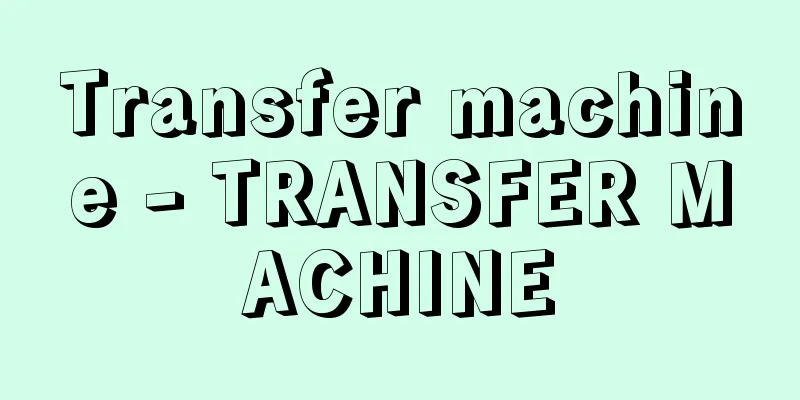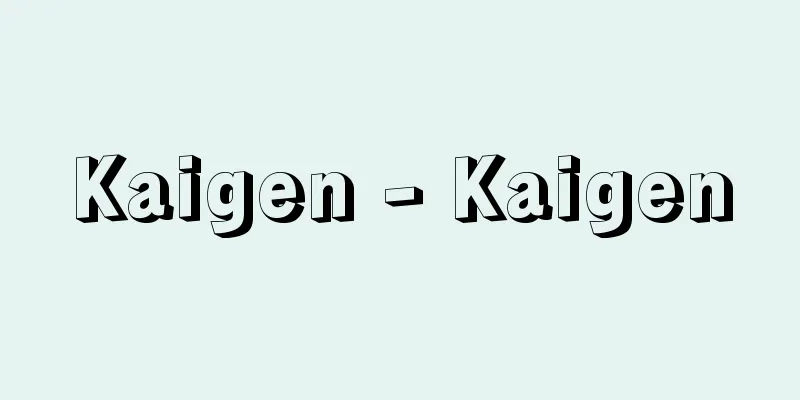Transfer machine - TRANSFER MACHINE

|
A machine tool that combines an automated machine tool with an automatic transport device to perform a series of machining operations all automatically. It was developed by the American Ford Motor Company after World War II for machining engine cylinder blocks, and quickly became famous, spreading to industrial countries around the world. Transfer machines, which combine many single-purpose machine tools to perform a series of operations automatically, are the basis of automation in the machining industry. The workpiece is supplied from one end of this machine, and is automatically transported and set at the machining position (station) by a moving work table. The station is equipped with an automatic machine tool, and when the workpiece arrives at this position, the required machining is automatically performed. Once machining is complete, it is transported to the next station and moved in sequence, and the completed workpiece is sent out from the last station. It is a remarkable machine that brought about a turning point in the automation of machining operations. [Hidetaro Nakayama] compositionFor machining, machine tools such as lathes, drill presses, and milling machines are used separately depending on the purpose of the processing. Each time a material is to be processed, a blade is set according to the type of processing and dimensions, and the workpiece or blade is driven by a motor or other device to perform the processing. When the processing is finished, the machine is stopped, the workpiece is removed, and it is carried to another machine tool for the next processing, where it is installed and processed again. A transfer machine gathers all these machine tools in one place, connects the processing positions to each other, and allows the workpiece to be moved from one processing position to the next. Drilling, threading, facing, and other processing are performed simultaneously at each station, and the processing time at each station is roughly the same. Therefore, processing is completed simultaneously and the processing machines at each station stop. The platform carrying the workpiece moves, carrying the workpiece after processing to the next station. There are various types of stations, such as those arranged in a linear row, those arranged in a circle, and those arranged in a skewer shape. Some are large, with a total length of several hundred meters and more than 100 stations. [Hidetaro Nakayama] FeaturesTransfer machines were created for the purpose of automating all the machining of automobile engine blocks. The movement of the table on which the workpiece is placed and the machine tools installed in the station are all automated and can be operated with the push of a button. Therefore, one person can operate several hundred machines. Compared to one operator for one machine tool, transfer machines can significantly reduce the number of operators required. Therefore, transfer machines greatly improve labor productivity. Also, because all machining is done by automatic machines, products of consistent quality can be produced and there are effects such as a reduction in work in progress, so although the capital investment is large, there is also an effect of reducing labor costs, and so they have become widely used in automobile production factories. Transfer machines can be operated with a button on the control panel, but usually two or three people are assigned to maintain the machines in case of breakdowns. [Hidetaro Nakayama] Spread to other industriesTransfer machines, which became popular in the automobile industry, proved effective in automating machining, so the trend to use transfer machines whenever possible for machining spread to other industrial fields. The automation of machining using transfer machines gradually increased for motor frames, camera bodies, and other products. Transfer machines were developed as processing machines for mass production, but as society developed, there was a demand for diversification of products. In order to meet this demand, attempts were made to unitize each station and to make it possible to change stations depending on the purpose. Furthermore, with the development of electronics, the processing at each station is no longer always the same, but can be changed at any time, making it easy to automatically perform a wide variety of machining processes. Furthermore, by combining the entire machine with a computer and digitally controlling it, the automation of machining has progressed even further. Because the automation of machining using transfer machines had many advantages, the wave of automation spread beyond machining to other fields, promoting the automation of all kinds of industries, including the electric power, steel, and chemical industries, and ushering in the so-called age of automation in the second half of the 20th century. [Hidetaro Nakayama] [See also] |Source: Shogakukan Encyclopedia Nipponica About Encyclopedia Nipponica Information | Legend |
|
自動化された工作機械と自動運搬装置とが結合され、一連の機械加工をすべて自動的に行う工作機械。第二次世界大戦後、アメリカのフォード自動車会社でエンジンのシリンダー・ブロック加工用に開発し、一躍有名になり、世界の各工業国に普及した。多くの単能工作機械が組み合わされ一連の加工を自動的に行うトランスファーマシンは、機械工業のオートメーションの基礎となっている。この機械の一端から被工作物が供給され、動く工作台によって加工位置(ステーション)に自動的に運ばれセットされる。ステーションには自動工作機械が設備されていて、この位置に被工作物がくると、自動的に所要の加工が行われる。加工が終わると次のステーションに運ばれ順次移動し、最後のステーションからは加工を完了したものが送り出される。機械加工の自動化に一転機をもたらした注目すべき機械である。 [中山秀太郎] 構成機械加工は旋盤、ボール盤、フライス盤などの工作機械が、加工の目的によってそれぞれ単独で使用されている。これらの工作機械には、加工を行おうと思う素材をそのつど機械に取り付け、刃物を加工の種類、寸法に応じてセットし、モーターなどにより加工物または刃物を駆動して加工を行う。加工が終われば機械を停止し、被加工物を取り外し、次の加工のために別の工作機械にまで運び、そこで取り付け、加工を行う。 これらの工作機械を一か所に集め、加工位置を互いに連結し、一つの加工位置から次の加工位置まで被工作物を移動できるようにしたものがトランスファーマシンである。穴あけ、ねじ切り、面削り、その他の加工が各ステーションで一斉に行われ、各ステーションでの加工時間はほぼ同じになっている。そのため、加工は一斉に終了し、ステーションの加工機械は停止する。被加工物をのせた台は移動し、それぞれの加工を終わった工作物を次のステーションまで運んでいく。ステーションは一列に直線的に配列しているもの、円形に配列しているもの、串(くし)形配列のものなどいろいろある。全長何百メートル、ステーションの数も100以上という大型のものもある。 [中山秀太郎] 特徴トランスファーマシンは自動車のエンジン・ブロックの加工をすべて自動的に行う目的でつくられたものである。被加工物ののせてある台の移動も、ステーションに設備されている工作機械もすべて自動化され、ボタン一つで操作できる。したがって数百台の機械の運転も1人でよい。1台の工作機械に一人の操作員がついているのに比べると、トランスファーマシンは操作のための人員をかなり削減できる。したがってトランスファーマシンによる労働生産性の向上は大きい。またすべて自動機械で加工が行われるので、品質のそろったものができ、仕掛け品の減少などの効果もあるので設備投資額は大きいが、人件費の減少などもあり、自動車の生産工場に広く普及した。トランスファーマシンは操作盤にあるボタンで稼動できるが、通常、故障のときなどに備えて機械の保守のため2、3人が配置される。 [中山秀太郎] 他の産業への波及自動車産業に普及したトランスファーマシンは、機械加工の自動化に威力を発揮したため、機械加工はできるだけトランスファーマシンを使用しようという傾向が強まり、他の産業分野にも広まった。モーターの枠、カメラのボディその他トランスファーマシンによる機械加工の自動化はしだいに増加した。なおトランスファーマシンは大量生産用の加工機械として発達してきたが、社会の発展とともに生産品の多様化が要求されるようになり、それに対応するため、各ステーションのユニット化が試みられ、目的によってステーションを交換できるようなくふうがされるようになった。さらにエレクトロニクスの発達もあって、各ステーションの加工もつねに同じものではなく、随時変更することもでき、変化に富んだ機械加工を自動的に容易に行えるようになった。さらにこの機械全体をコンピュータと組み合わせ、デジタル制御を行い機械加工の自動化は一段と進むようになった。 トランスファーマシンによる機械加工の自動化は多くの優れた点があったために、機械加工だけでなく、他の分野にも自動化の波は広がり、電力工業、製鉄工業、化学工業などあらゆる工業の自動化を推進し、いわゆる20世紀後半のオートメーション時代の到来となった。 [中山秀太郎] [参照項目] |出典 小学館 日本大百科全書(ニッポニカ)日本大百科全書(ニッポニカ)について 情報 | 凡例 |
<<: Transfer problem - Transfer problem
Recommend
Tischbein, JHW (English spelling) TischbeinJHW
...There were more than 20 painters in this famil...
Palmella
...The first three species are sessile, while the...
Ligularia dentata (English spelling) Ligulariadentata
… [Mitsuru Hotta]... *Some of the terminology tha...
Hanging (cocoon) - Hanging
…It is a multiplier used to calculate the price i...
Tororo soup (yam soup) - tororojiru
This dish is made by grating yams such as Jinenjo ...
Standing song - Tateuta
〘 noun 〙 A person who takes the lead in Nagauta, t...
Official money (official rank) - Kankin
…There were also official ranks for monks, Shinto...
luni-sidereal calendar
…Here, the appearance of 12 to 19 stars and const...
Ṭighnarī (English spelling) Tighnari
...This style of description had a great influenc...
Peat layer ruins - peat bog ruins
In Japanese archaeology, artifact-bearing layers t...
Gitanjori - Gitanjori
…This is a representative collection of poems by ...
stoicheia
... The English word "element," the Fre...
Awa [town] - Awa
A former town in Awa District, northern Tokushima ...
Cannabis sativa; hemp
An annual plant of the mulberry family. Sometimes ...
Tomeyama
Among the forests of feudal lords in the early mo...









